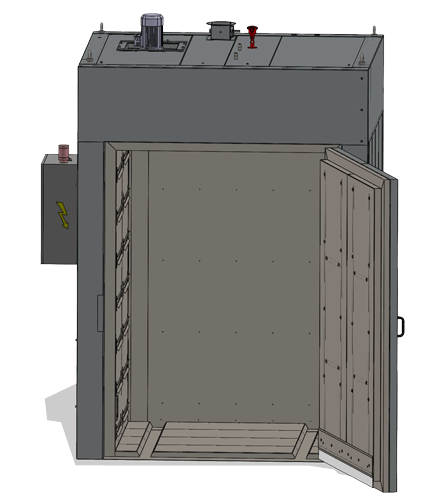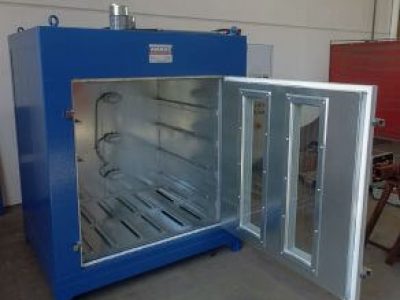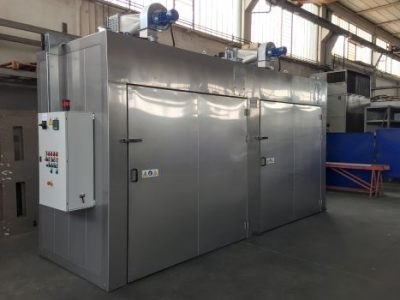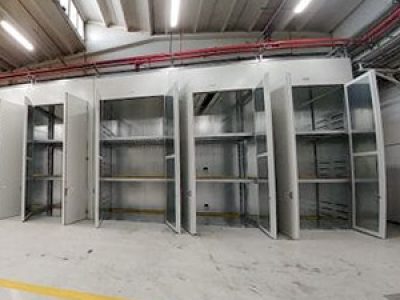Industrial Ovens
The production chains of majority of the industrial processes that create finished or semi-finished products require heating applications.
From the time AMARC was established in 1954, its mission has been to design and create technical solutions allowing customers to efficiently control the industrial heating process used in their productions.
For more than 30 years, the know-how of thermal processes has been aimed at the creation of industrial air convection ovens with operating temperatures up to +250°C.





2 Ovens for the biomedical sector

Series of ovens for the cosmetics sector

Oven with 4 zones for the composites sector

2 Ovens for the abrasives sector
Application and Reference sectors
There are a large number of applications for AMARC industrial ovens in industrial heating processes and they differ from sector to sector.
The most common applications (even though they are not the only ones) are:
Polymerisation, Drying, Pre-heating, Thermal treatment, Thermoforming processes, Stress-relief, Stabilisation, Curing, Hardening, Vulcanisation, Post-heating, Maintenance.
Construction
The AMARC industrial ovens consist of a welded carbon steel frame to which the load-bearing walls are fixed, made of suitably assembled metal sheets and panels made of insulating and “absestos free” mineral wool, i.e. devoid of any asbestos component.
AMARC industrial ovens main features are:
- Structural sturdiness. The industrial ovens are designed to run in continuous cycle, withstanding the stresses and undesirable impacts during the loading and unloading steps over a long period.
- Thermal Insulation. The structure is designed without thermal bridges and suitably insulated, thereby ensuring minimum dispersal, efficient heat exchange and resulting energy saving.
- Materials. The standard construction comprises: the external body of the oven made of carbon steel painted.
Oven interior in galvanised steel. Sealed construction with seam-welded panels:- When the operating temperature increases;
- In the presence of high pressure in the chamber;
- For processes with dense and/or aggressive emissions.

Batch of ovens under manufacture

Batch of ovens ready for testing

Oven interior chamber made of stainless steel watertight welded

Horizontal flow

Vertical flow

Mixed flow
Operation
The heat transfer process mainly takes place by air convection.A resistive unit receives an air flow which is then directed onto the material through slits meant for the purpose.
The process is “controlled” by a digital temperature regulator installed inside the control panel and paired with a probe installed in a suitable position.
Research into air flows is of fundamental importance since it allows us to obtain:
- The best possible heat distribution;
- A significantly faster temperature ramp;
- Heat transfer as required.
The air flows are tailored to suit the shapes of the parts that need to be heated and the required temperature accuracy.
The flows may be:
Well-designed air flows and electric power modulation allow extremely even temperatures to be obtained inside the oven.
AMARC can design ovens with +/- 2°C tolerance with respect to the empty chamber temperature setting.
All AMARC ovens are subjected to «mapping» of the temperatures by qualified laboratories using certified calibration instruments.
Products Range
The AMARC know how is aimed at the design and production of ovens for processes that need operating temperatures up to +250°C.
"Custom" Industrial Ovens
Within this temperature range, AMARC can provide its customers with every type of custom solution (see main custom oven projects) to satisfy the following specifications:
- Operating temperature and relative accuracy (+ / – °C);
- Working dimension inside the chamber ;
- Loading method;
- “Stand alone” mode (“batch” ovens) or inserted in automatic lines (continuous cycle ovens);
- Temperature control logics;
- Safety devices;
- Automation level;
- Customisations, optionals, accessories.
“Standard” Industrial Ovens
Over thirty years of experience in the creation of customized solutions has enabled AMARC to use its know-how in designing standard series:
- FCS 150 series standard ovens (for processes up to +150°C)
- FCS 250 series standard ovens (for processes up to +250C)
These «batch» ovens, electric heated, with their variety of sizes and options, are a versatile and efficient solution for a number of thermal processes.

Standard Oven FCS 150-03

Standard Oven FCS 150-03

Standard Oven FCS 150-13

Standard Oven FCS 150-13

Standard Oven FCS 250-01

Standard Oven FCS 250-01

Standard Oven FCS 250-08

Standard Oven FCS 250-08
| Model | Max Temp. (C°) | Internal Dimensions | Volume (m³) | Fan Flow Rate (m³/h) | Power (kW) | ||
|---|---|---|---|---|---|---|---|
| Height (mm) | Width (mm) | Depth (mm) | |||||
| FCS 150-01 | 150 | 1500 | 1000 | 1000 | 1,5 | 3050 | 15 |
| FCS 150-02 | 150 | 1500 | 1500 | 1000 | 2,25 | 3050 | 22,5 |
| FCS 150-03 | 150 | 1500 | 1500 | 1500 | 3,375 | 3050 | 22,5 |
| FCS 150-04 | 150 | 2000 | 1500 | 1500 | 4,5 | 3050 | 30 |
| FCS 150-05 | 150 | 2000 | 1500 | 2000 | 6 | 3850 | 30 |
| FCS 150-06 | 150 | 2000 | 1500 | 2500 | 7,5 | 4750 | 37,5 |
| FCS 150-07 | 150 | 2000 | 1500 | 3000 | 9 | 5400 | 37,5 |
| FCS 150-08 | 150 | 2000 | 2000 | 1500 | 6 | 3850 | 30 |
| FCS 150-09 | 150 | 2000 | 2000 | 2000 | 8 | 4750 | 37,5 |
| FCS 150-10 | 150 | 2000 | 2500 | 1500 | 7,5 | 4750 | 37,5 |
| FCS 150-11 | 150 | 2000 | 2500 | 2000 | 10 | 6150 | 37,5 |
| FCS 150-12 | 150 | 2000 | 3000 | 1500 | 9 | 5400 | 37,5 |
| FCS 150-13 | 150 | 2000 | 3000 | 2000 | 12 | 6150 | 45 |
The data in the Table are not to be considered as contractually binding. AMARC srl reserves the right to make modifications without prior notification.
| Model | Max Temp. (°C) | Internal Dimensions | Volume (m³) | Fan Flow Rate (m³/h) | Power (kW) | ||
|---|---|---|---|---|---|---|---|
| Height (mm) | Width (mm) | Depth (mm) | |||||
| FCS 250-01 | 250 | 1500 | 1000 | 1000 | 1,5 | 3050 | 22,5 |
| FCS 250-02 | 250 | 1500 | 1500 | 1000 | 2,25 | 3050 | 30 |
| FCS 250-03 | 250 | 1500 | 1500 | 1500 | 3,375 | 3050 | 30 |
| FCS 250-04 | 250 | 2000 | 1500 | 1500 | 4,5 | 3050 | 37,5 |
| FCS 250-05 | 250 | 2000 | 1500 | 2000 | 6 | 3850 | 37,5 |
| FCS 250-06 | 250 | 2000 | 1500 | 2500 | 7,5 | 4750 | 45 |
| FCS 250-07 | 250 | 2000 | 1500 | 3000 | 9 | 5400 | 45 |
| FCS 250-08 | 250 | 2000 | 2000 | 1500 | 6 | 3850 | 37,5 |
| FCS 250-09 | 250 | 2000 | 2000 | 2000 | 8 | 4750 | 45 |
| FCS 250-10 | 250 | 2000 | 2500 | 1500 | 7,5 | 4750 | 45 |
| FCS 250-11 | 250 | 2000 | 2500 | 2000 | 10 | 6150 | 45 |
| FCS 250-12 | 250 | 2000 | 3000 | 1500 | 9 | 5400 | 45 |
| FCS 250-13 | 250 | 2000 | 3000 | 2000 | 12 | 6150 | 52,5 |
The data in the Table are not to be considered as contractually binding. AMARC srl reserves the right to make modifications without prior notification.
Optionals
UA product made to measure
Different production sites and different thermal processes require the possibility of configuring the oven with a certain degree of versatility. All AMARC ovens, in the standard FSE 150 and FSE250 versions as well as in the totally “custom” versions can be configured with a series of optional designed to completely satisfy the needs of every customer.
AMARC wants to offer its customers solutions, not just products!
 +
Materials
+
Painting
+
Heating Cabinet Bottom
+
Doors
+
Air extraction and renewal system
+
Moisture extraction systems
+
Process Optional and Operating Logic
+
Materials
+
Painting
+
Heating Cabinet Bottom
+
Doors
+
Air extraction and renewal system
+
Moisture extraction systems
+
Process Optional and Operating Logic
UE Reference Standards
All Amarc industrial ovens, from the standard series FSE150 – FSE250 oven to the custom oven, fall within the field of application of Machinery Directive 2006/42/EC and refer to harmonised standards and European standards as regards the safe construction of machinery.
Machinery Directive 2006/42/EC;
Standards EN12100, EN60204-1, EN13849-1, EN62061, EN61508-1, 2, 6.
Continuous Cycle Ovens
The design and construction of continuous cycle ovens complete the offer of AMARC solutions.
The continuous cycle ovens are the highest level of customization in the design and production of ovens, combining the study of the thermal process and the transport of materials-parts to be heated.
The choice of continuous cycle ovens is based on the efficiency criteria when two conditions exist:
- The oven is inserted in an automatic line inside a highly automated production chain.
- The production involves a series of parts identical as regards shape and dimensions and which are conveyed through a thermal process that is constantly repeated.
The sizing of the oven is determined taking into account the dimension of the parts, their thermal features, the output required in the time unit, the space provided by the customer, the loading and unloading methods.
From the process point of view, they satisfy a large number of applications such as: drying, polymerisation, firing, pre-heating, stabilisation, annealing, different thermal treatments.

Continuous cycle oven for post curing treatment of small metal parts automatic loading and unloading

Continuous cycle oven for post curing treatment of small metal parts automatic loading and unloading

Continuous cycle oven with metal mesh conveyor, for polymerisation process

Continuous cycle oven with metal mesh conveyor, for polymerisation process

Continuous oven for annealing process with double heating stage

Continuous cycle oven for pre-heating process, "Step-step" movement, double conveyor


Continuous cycle oven for polymerisation treatment with silicone conductive gaskets


Example of metal mesh oven conveyor

Example of oven chain conveyor with plates for placing the parts

Example of oven chain conveyor with AISI304 stainless steel basket for receiving parts
Continuous Cycle Ovens Customisation
- Conveying method: depending on the dimensions and weight of the material to be handled, the conveyor may be a metallic mesh, chain conveyor or motor-operated roller conveyor.
- Advancement in continuous cycle or in steps.
- Single-zone or multiple-zone oven with different heat treatment steps (e.g.: different temperatures, pre-heating with infra-red lamps, final cooling…).
- Automatic or manual loading/unloading.
- Construction materials: Like all Amarc ovens, there is a large range of construction materials.






























